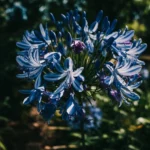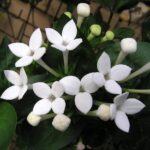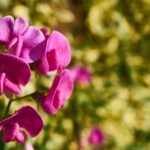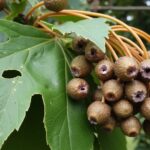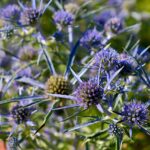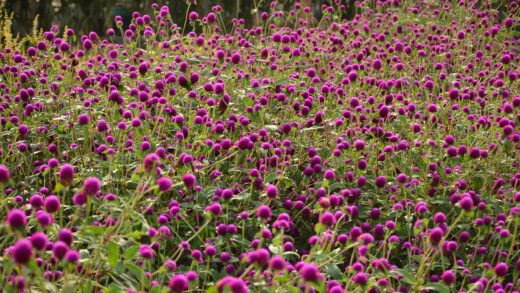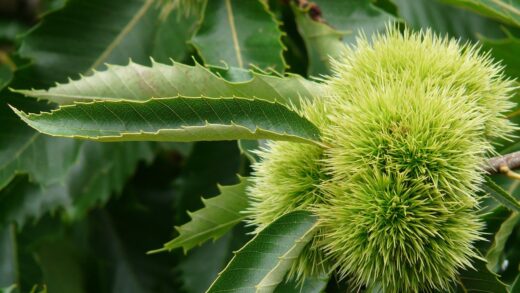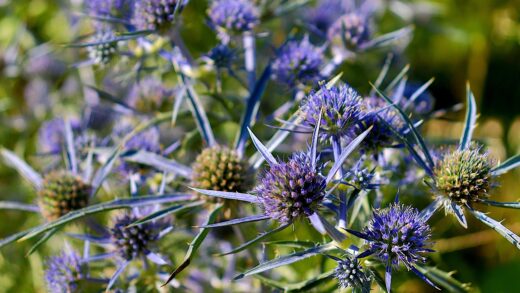While the Asian persimmon is renowned for being a relatively resilient and low-maintenance fruit tree, it is not entirely immune to the challenges posed by diseases and pests. A proactive approach to orchard health, grounded in prevention, early detection, and integrated management, is key to keeping these potential threats at bay. Understanding the specific pathogens and pests that can affect persimmon trees allows growers to implement targeted strategies that protect the tree’s health and ensure a clean, high-quality fruit harvest. Maintaining a vigilant watch and fostering a healthy growing environment are the best defenses against significant crop loss or damage.
The overall health of a persimmon tree is its primary defense against diseases and pests. A tree that is stressed due to poor nutrition, improper watering, or an unsuitable planting location is far more susceptible to attack than a tree that is growing vigorously in optimal conditions. Therefore, the first line of defense is always sound horticultural practice. This includes ensuring the tree is planted in well-drained soil, receives adequate sunlight, is properly pruned to promote good air circulation, and is supplied with balanced nutrition.
Many of the most common diseases that affect persimmon trees are fungal in nature and thrive in damp, humid conditions. Problems like anthracnose, leaf spot, and sooty mold are often exacerbated by poor air movement through a dense canopy and overhead irrigation that keeps the foliage wet for extended periods. Preventative measures, such as pruning to open up the canopy and using drip irrigation instead of sprinklers, can dramatically reduce the incidence of these fungal issues. Regular sanitation, such as removing and destroying fallen leaves and diseased fruit, is also crucial to reduce the overwintering sources of fungal spores.
Insect pests can also pose a threat, though persimmons tend to have fewer insect problems than many other fruit trees. Pests like scale insects, mealybugs, and the persimmon psylla can feed on the tree’s sap, weakening it and sometimes causing cosmetic damage to the fruit. In some regions, fruit flies or borers can be more serious concerns. An integrated pest management (IPM) approach, which emphasizes monitoring and uses the least toxic control methods first, is the most sustainable way to manage these pests. This may include encouraging beneficial insects, using horticultural oils, or applying targeted insecticides only when pest populations reach a damaging threshold.
Common fungal diseases affecting persimmons
One of the most frequently encountered fungal diseases in persimmon trees is Cercospora leaf spot. This disease typically appears in mid to late summer, especially during warm, wet weather. It manifests as small, circular to angular dark spots on the leaves. As the disease progresses, the spots may enlarge, and heavily infected leaves can turn yellow and drop prematurely. While this disease rarely causes severe harm to the tree itself, significant premature defoliation can weaken the tree and may affect the proper ripening and sugar development of the fruit.
More articles on this topic
Anthracnose is another fungal disease that can affect persimmon leaves, twigs, and fruit. On leaves, it causes irregular, dark, sunken lesions, while on fruit, it results in dark, circular, sunken spots that can eventually lead to fruit rot. The fungus overwinters in infected plant debris and on cankers in the tree, releasing spores during wet spring weather. Good sanitation, including the removal of fallen leaves and fruit at the end of the season and pruning out any cankered or dead branches, is a critical step in managing the spread of anthracnose.
Crown gall, caused by the soil-borne bacterium Agrobacterium tumefaciens, can also be a serious issue for persimmon trees. This disease is characterized by the formation of large, woody, tumor-like galls on the roots and at the crown of the tree, just at the soil line. These galls disrupt the flow of water and nutrients, which can lead to stunted growth, yellowing leaves, and a general decline in the tree’s health. There is no chemical cure for crown gall, so prevention is paramount. This includes sourcing disease-free nursery stock and avoiding any injury to the tree’s roots or lower trunk during planting and cultivation.
Managing these fungal and bacterial diseases relies heavily on cultural practices. Proper pruning to improve air circulation within the canopy helps the foliage dry more quickly after rain, creating a less hospitable environment for fungal spores to germinate. Avoiding overhead irrigation further reduces leaf wetness. In cases of severe or persistent infection, preventative fungicide sprays applied in the spring may be necessary. However, for most home gardeners, a focus on sanitation and cultural control is sufficient to keep these diseases in check.
Identifying and managing common insect pests
Scale insects are one of the more common pests found on persimmon trees. These small, immobile insects attach themselves to the bark of twigs, branches, and sometimes the fruit, covering themselves with a protective waxy shell. They feed by sucking sap from the tree, and a heavy infestation can lead to reduced tree vigor, yellowing leaves, and sooty mold, which grows on the sticky “honeydew” that the scale insects excrete. Control can be achieved by spraying the tree with horticultural oil during the dormant season, which smothers the overwintering scales.
More articles on this topic
The persimmon psylla is another sap-sucking pest that can affect new growth in the spring. The nymphs of this insect feed on the tender young leaves, causing them to curl and become distorted. While the damage is mostly cosmetic and mature trees can easily tolerate a light infestation, heavy populations can stunt the growth of young trees. Monitoring for the pest in early spring and applying horticultural oil or insecticidal soap before the leaves curl tightly can help to manage their numbers. Encouraging natural predators like ladybugs and lacewings also provides effective biological control.
In some areas, borers such as the persimmon trunk borer can cause significant damage. The larvae of this beetle tunnel into the trunk and main branches of the tree, disrupting the vascular tissue and weakening the tree’s structure. Signs of a borer infestation include small holes in the bark, sawdust-like frass (excrement) being pushed out of the holes, and a general decline in tree health. Keeping trees healthy and vigorous is the best defense, as borers tend to target stressed or weakened trees. Probing the tunnels with a wire or using specific insecticides can control existing larvae.
Mealybugs are another pest that can occasionally become a problem, particularly in warmer climates. These soft-bodied insects are covered in a white, waxy, cottony substance and tend to congregate in protected areas, such as the calyx of the fruit or in bark crevices. They also feed on sap and excrete honeydew, leading to sooty mold. Management strategies are similar to those for scale insects, including the use of horticultural oils and the encouragement of natural enemies. Spot treatments with insecticidal soap can also be effective for localized infestations.
Vertebrate pests and protective measures
Beyond insects and diseases, various vertebrate pests can cause significant damage to persimmon trees and their fruit. Birds, such as crows, jays, and starlings, are often attracted to the ripening fruit. They can peck at and destroy a substantial portion of the crop, especially the softer, ripened fruits. The most effective method for protecting the harvest from birds is to cover the entire tree with lightweight bird netting a few weeks before the fruit begins to ripen. Ensure the netting is secured at the bottom to prevent birds from getting trapped inside.
Mammals can also pose a threat to both the tree and its fruit. Deer may browse on the leaves and tender shoots, particularly of young trees, and can also damage the bark by rubbing their antlers against the trunk. Protective measures include installing sturdy fencing around the orchard or placing individual tree guards or wire cages around young trees. Various repellents are also available, but their effectiveness can be variable and they often need to be reapplied after rain.
Smaller mammals like squirrels, raccoons, and opossums are adept climbers and are notorious for stealing ripening fruit. Managing these pests can be particularly challenging. One effective strategy is to install a metal or smooth plastic baffle on the trunk of the tree, similar to those used on bird feeder poles, to prevent them from being able to climb up into the canopy. Keeping the area around the tree clear of debris and ensuring that branches do not provide a “bridge” from other trees or structures can also help to deter them.
In some cases, ground-dwelling animals like rabbits or voles can damage the base of young persimmon trees by gnawing on the bark, especially during the winter when other food sources are scarce. This girdling can be fatal to the tree. The best protection is to place a hard plastic or wire mesh tree guard around the trunk of the young tree, making sure it extends a few centimeters below the soil line to prevent voles from tunneling underneath it. These preventative measures are crucial for protecting the tree from the wide range of wildlife that may be attracted to it.
Integrated pest management principles
Integrated Pest Management (IPM) is a sustainable and common-sense approach to managing pests and diseases that minimizes risks to human health and the environment. The foundation of IPM is regular monitoring and correct pest identification. This involves frequently scouting the persimmon trees to check for the presence of pests or disease symptoms. By catching problems early, you can often manage them with simple, non-chemical methods before they escalate into a major issue. Correctly identifying a pest is crucial to ensure that any control measure used will be effective.
IPM emphasizes the use of cultural and mechanical controls as the first line of defense. For persimmon trees, this includes practices like selecting disease-resistant varieties, maintaining proper sanitation by cleaning up fallen leaves and fruit, pruning to improve air circulation, and using physical barriers like bird netting or tree guards. These non-intrusive methods are designed to make the environment less favorable for pests and pathogens, preventing many problems from ever starting.
Biological control is another key component of IPM, which involves using a pest’s natural enemies to keep its population in check. This can be achieved by creating a habitat that is attractive to beneficial insects like ladybugs, lacewings, and predatory wasps, which feed on pests like aphids and scale. This often involves planting a diversity of flowering plants near the orchard and avoiding the use of broad-spectrum pesticides that would harm these beneficial allies.
Chemical controls, such as pesticides and fungicides, are used in an IPM program only as a last resort, when monitoring indicates that they are necessary to prevent significant damage. When they are used, the emphasis is on selecting the least toxic and most targeted product available (such as horticultural oils or insecticidal soaps) and applying it in a way that minimizes impact on non-target organisms and the environment. This judicious use of chemicals is a stark contrast to calendar-based spraying programs and represents a more intelligent and sustainable approach to pest control.










